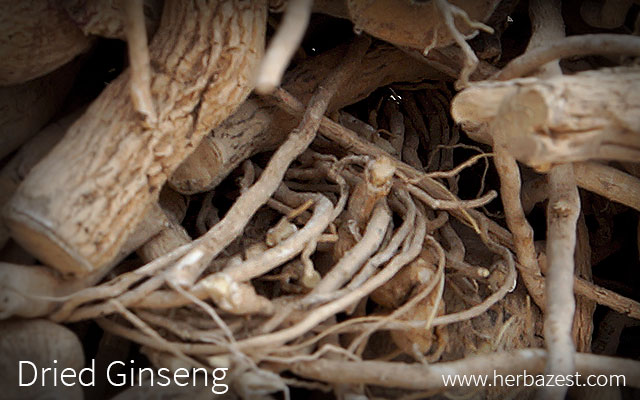Ginseng has proven its capabilities to improve human health over thousands of years. In order to enjoy ginseng's benefits at their fullest potential, it is important to know about the effect different preparation and storage techniques have on the herb. When treated properly, dried ginseng has proven to be the more beneficial option compared to fresh ginseng.
Dried Ginseng and Raw Ginseng
While drying ginseng adds an additional step to its already lengthy growing process, it exponentially increases the benefits of the herb. A study published in the Journal of Natural Products (2000) found that steaming raw ginseng at 248°F (120°C) produced three ginsenosides that weren't present in the raw herb. Two of them make up 58% of the total ginsenosides in the herb, increasing its overall value.
Two well-known byproducts of the different methods of drying ginseng are white ginseng and red ginseng. However, more recently, a black ginseng preparation is getting lots of attention from the scientific community because of its enhanced properties. White ginseng is the consequence of allowing raw ginseng to dry in the sunlight, while red ginseng is the result of a rigorous process of steaming, and black ginseng is derived from a repeated steaming and drying technique.
Ginsenoside levels in red ginseng are higher than in white ginseng. On the other hand, black ginseng is higher in a particular type of ginsenoside, Rg3, which confers it unique benefits.
How to Dry Ginseng
Dried ginseng is obtained by using dehumidifiers, heaters, wood stoves, fans, and even homemade contraptions. No matter what method is used, the temperature and airflow must be closely monitored. If the temperature drops below 70°F (21°C), the roots will get moldy before they dry, and the outside of the root will become brittle while the inside remains green if the temperature rises above 95°F (35°C).
To ensure proper airflow, the ginseng roots should be placed separated, rotated occasionally, and flipped after 36 hours to prevent moisture buildup and mold growth. Keeping the roots on a rack with screens allows the entire root to be open to airflow all at once.
Depending on the environmental conditions and the technique used, obtaining dried ginseng may take anywhere from a few days to several weeks. You will know your dried ginseng is ready when the roots are easy to break and are all white on the inside. They can be stored in paper bags or boxes.
How to Use Dried Ginseng
In order to disguise the strong, somewhat displeasing taste of this root, many ginseng supplements have been developed over the years. One of the most popular ways to reap the benefits of dried ginseng is by infusing it in a soothing tea or soup. Ginseng powder can be used in culinary dishes, often sprinkled on a meal like a seasoning, or it can be enclosed in a capsule to be taken in controlled doses. Regardless of the form in which it is taken, the general dosage for dried ginseng root is one to two grams daily.
Benefits of Dried Ginseng
The antioxidant properties of the dried ginseng root have made of this herb a popular supplement to help lower blood pressure, balance out glucose levels, stimulate immunity, relieve menopause symptoms, and treat erectile dysfunction.
Additionally, healthy individuals consume dried ginseng to improve memory, increase alertness, and enhance mental performance. However, these alleged benefits are based on tradition rather than scientific research.
Where to Buy Dried Ginseng
The majority of the market is focused on dried ginseng, as it is easier to store and handle than fresh ginseng. It is possible to find dried ginseng root for sale in herbal health stores, some retail stores, and online.
Because of its high ginsenoside content, as well as the variety of supplements that offer its benefits, dried ginseng has become a very popular option for treating a wide range of medical conditions and improving energy levels in healthy individuals.
Sources
- Biological and Pharmaceutical Bulletin, Increase in the Free Radical Scavenging Activity of Ginseng by Heat-Processing, 2005
- Ginseng: How to Find, Grow and Use North America's Forest Gold
- HerbalGram, The Pharmacologically Active Constituents of White and Red Ginseng Root, 2008
- HortTechnology, Asian and American Ginseng – A Review, 1995
- Internet Journal of the Institute for Traditional Medicine and Preventative Health Care, The Nature of Ginseng: From Traditional Use to Modern Research, 2002
- Journal of Ethnic Foods, Chemical composition characteristics of Korean straight ginseng products, 2014
- Journal of Ginseng Research, Comparative study of Korean White Ginseng and Korean Red Ginseng on efficacies of OVA-induced asthma model in mice, 2015
- Virginia State University, Cooperative Extension, Growing American Ginseng (Panax quinquefolious) in Forestlands
- Ohio State University, Extension, Growing American Ginseng in Ohio: Harvesting, Washing and Drying




